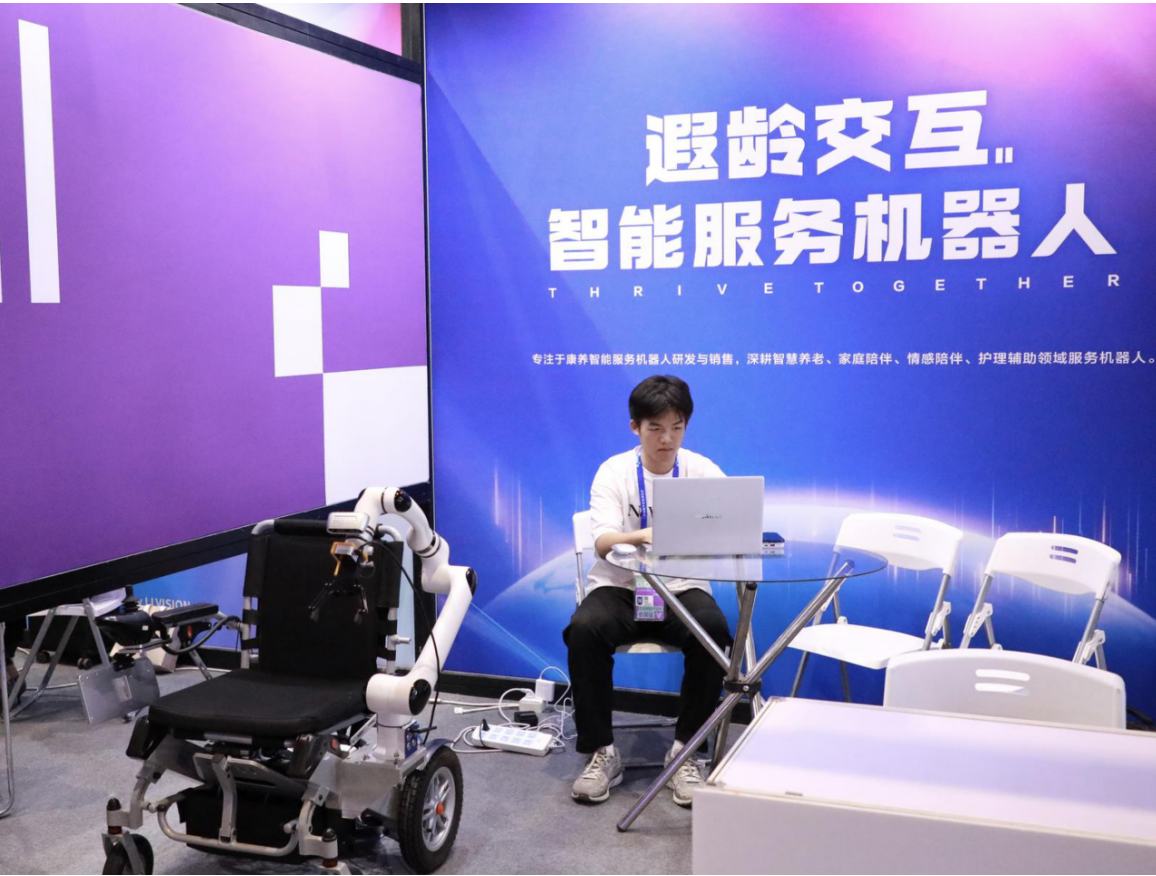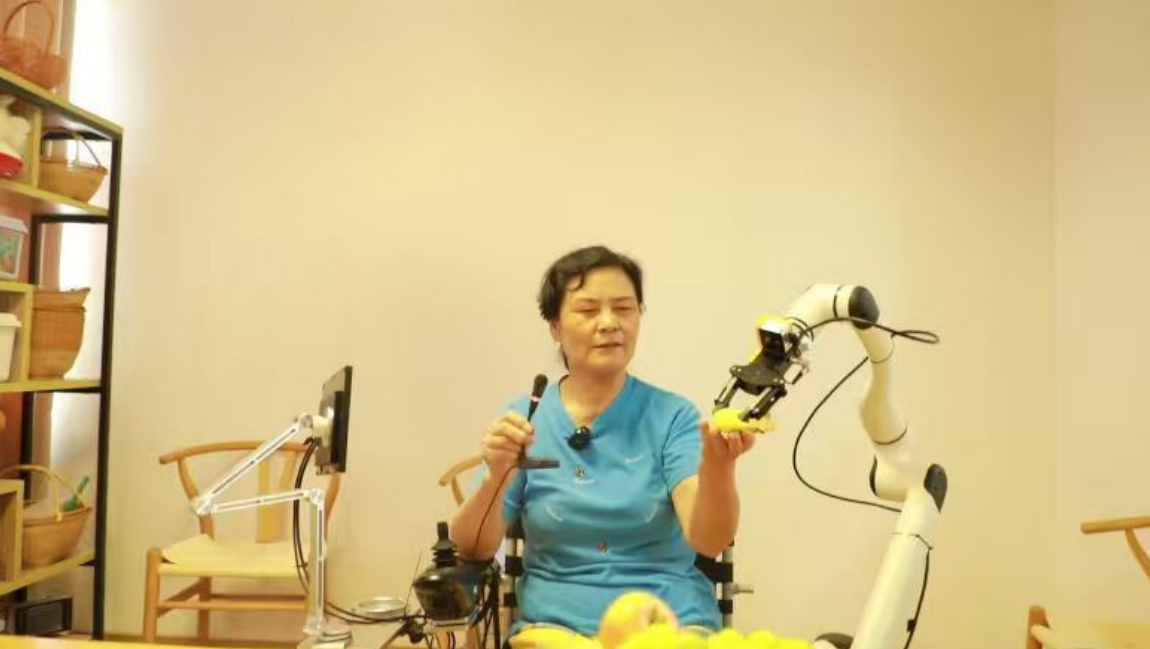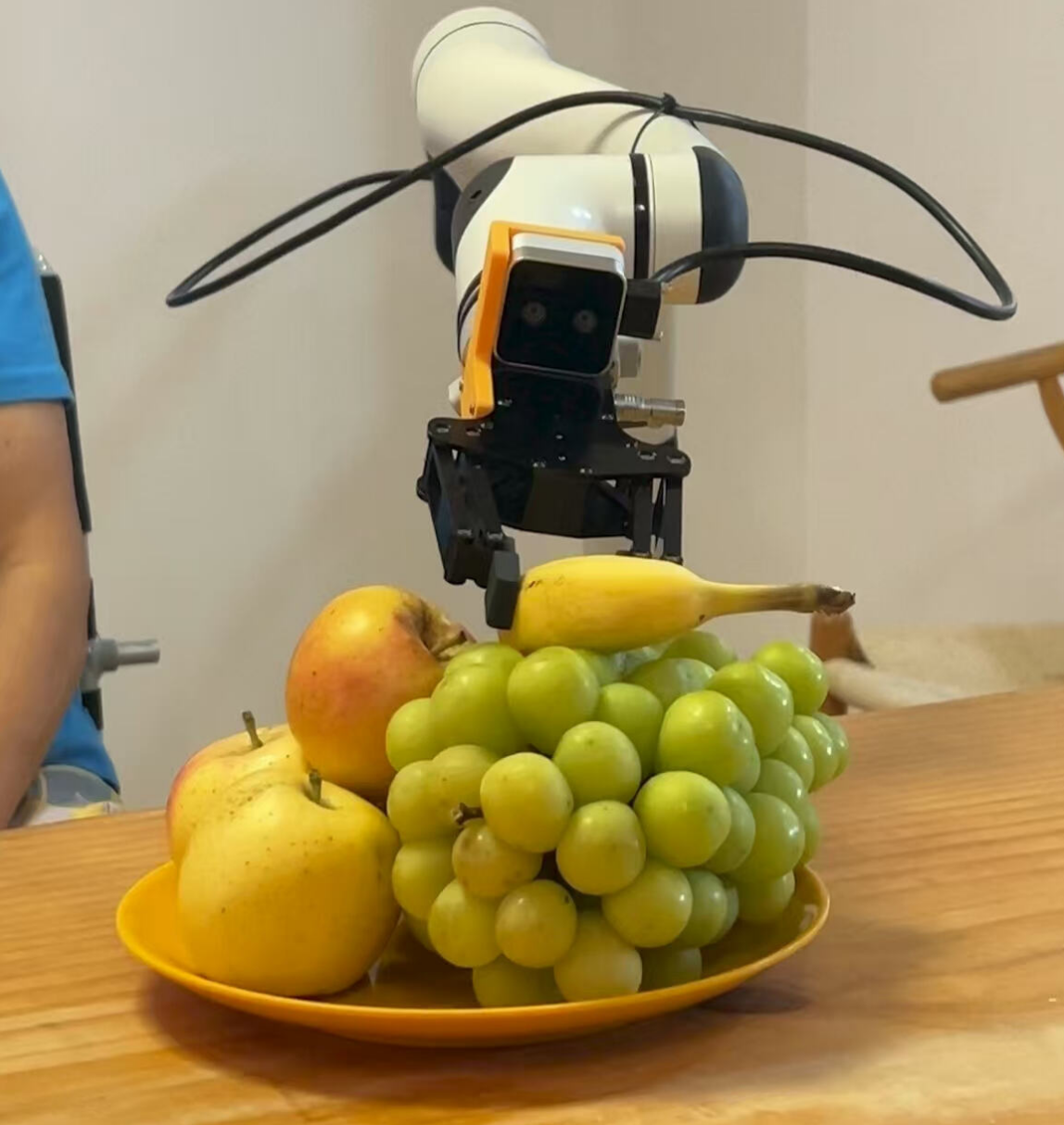At first glance, this is a very common robotic arm right now, grabbing eggs and pinching walnuts are powerful. But as soon as it encounters a human collision, it will instantly "release the force" and become as soft as a sponge.
lies in the special material structure embedded in the interior, which can autonomously adjust the stiffness of the mechanical arm by sensing the rate of external impact, similar to the human knee jump reflex, without passing through the brain.
"We want to develop a robot that can gently hug children, a partner that can safely support the elderly, and an assistant that can safely assist workers, just like the robot in Disney's animated movie" The Great Marine Corps." Jiang Hanqing said.
a professor of mechanical engineering at the West Lake University Institute of Technology and founder of the West Lake Interactive Machine, with a group of post-90s and post-95s, tried to redefine the safety and temperature of human-computer interaction through his familiar mechanical language and AI technology. In their view, this "rigid and flexible" design may provide a "gentle solution" to deal with an aging society ".
01 Iron Man Has Soft Arms
in Jiang Hanqing's vision, in order to truly integrate into human life and become a reliable partner in the future, it is very important to solve the safety problem of human-computer interaction. However, the robots on the market generally adopt rigid structure design, and perform well in the fields of industry and logistics, which is a certain distance from entering the scene of daily life.
make the steel body learn to be "gentle"? Mechanics may provide one of the answers.
walked into the laboratory of the West Lake interactive machine, we could see all kinds of strange "structures" everywhere. These are the mechanical metamaterials developed by the team.Unlike traditional materials, which rely on molecular or crystalline structures, mechanical metamaterials derive their properties entirely from artificially engineered elaborate configurations (geometries, structural hierarchies, combinations, etc.).is like a piece of soft paper, through different folding methods, can show or flexible or rigid mechanical properties.
three months ago, they launched their first molded product--Phi-A Flexible Variable Stiffness Manipulator,can realize the change of local stiffness at the millisecond level, automatically "soften" when encountering external force or close to the human body, and can immediately restore rigidity when switching tasks.
"The human hand touches the boiling water and the conditioned reflex retracts back. If the robot can also complete this fast and reliable response through materials and structures, it will have 'instinct '."Jiang Hanqing called this "instinct" physical intelligence.
"the core of this metamaterial, you can understand ita resistanceplug (jamming) mechanism."Jiang Hanqing explained. He uses an analogy with vacuum-packed rice from a supermarket: it is as hard as a brick when unopened, but once the package is cut open and put in air, it immediately becomes soft, "except that we fill it with a self-developed mechanical metamaterial. The switch between the soft and hard states relies on physical intelligence, with the air valve being controlled autonomously without external command intervention."
02 "gentle solution" from laboratory to nursing home"
the establishment of the West Lake Interactive Machine Company, Jiang Hanqing and his team saw the possibility of transforming the subject into landing products, especially in human-computer interaction scenarios such as health care, companionship and cooperation.
"For example, in the elderly care industry, China has a population of 1.4 billion and more than 0.4 billion households, and the shortage of nursing workers may be a common problem. Rigid robots are not fully qualified for nursing work, and we need safer solutions."
at present, this mechanical arm has been realizedmore than 90%universal humanoid robot platform. Since its release in February, commercialization attempts are also underway. The team has reached a cooperation with Medster, a home rehabilitation equipment brand, to jointly develop intelligent rehabilitation bedside equipment. The project has entered the user verification phase,expects to launch a small-scale pilot application within a year.
latest achievement is a wheeled humanoid robot to be released later this month, equipped with a variable stiffness robotic arm. "Science and technology should not only pursue stronger performance, but also focus on harmonious symbiosis with people."This self-research work of the whole machine, which started in October last year, carries Jiang Hanqing's thinking on the essence of science and technology.
"Especially in home and retirement scenarios, we need to equip robots with emotional perception, safe hugging and action negotiation capabilities. The key to achieving these functions is to accurately grasp the balance of rigid and flexible transitions-soft when it is soft, and firm when it is hard." In his view, this is not just an upgrade of technology, but the beginning of reconstructing the human-computer relationship.
03 Crossover Medal
, Jiang Hanqing received good news from the American Society of Mechanical Engineers (ASME)2025 ASME Daniel C.Drucker Medal.This medal is one of the highest honors established by ASME in the field of applied mechanics to recognize scientists who have made outstanding contributions to scientific research, teaching and academic services in the fields of applied mechanics and mechanical engineering for a long time.
, he became the first Chinese scholar to receive the medal and one of the youngest winners since the award was established.
Jiang Hanqing's academic path began with the engineering mechanics major of Dalian University of Technology, and then studied for a doctorate in solid mechanics at Tsinghua University, under the tutoring of the famous mechanic Academician Huang Kezhi. When he was young, Jiang Hanqing was very interested in computers, but the "safe" major chosen by his father became an important cornerstone of his future cross-border innovation.
"As a basic science, mechanics is to solve complex practical problems with the most basic principles."Jiang Hanqing's early research focused on traditional solid mechanics. When he went to the United States to engage in postdoctoral research at the University of Illinois in 2001, he first felt the great potential of the cross integration of material science, mechanics and electronic engineering; after teaching at Arizona State University in 2006, his research focus gradually shifted to emerging fields such as flexible electronics, deformable structures and smart materials.
deformable electronic devices began around 2010. At this time, Jiang Hanqing is keenly aware of the unique advantages of flexible systems in human-machine environment coupling, especially in medical, wearable devices, robots and other fields. It also convinced him,"Flexible technology is the next generation of human-computer interaction infrastructure".
the summer of 2021, Jiang Hanqing returned to China to join West Lake University full-time to establish a cross-mechanics laboratory because he believed that "there will be a brand-new combination of basic research and industrial transformation. This veritable interdisciplinary platform brings together researchers and students from different majors such as solid mechanics, mechanical engineering, materials science, computer science, and textile engineering.flexible mechanics, bionic structure, soft robot, edible electronic deviceand other directions.
Based on the transformation of laboratory research results, Westlake Interactive Machine Technology (Hangzhou) Co., Ltd. was established in September 2023"Flexible Robot + Body Intelligence"as the starting point to promote the realization of the vision of human-computer symbiosis. The CTO (Chief Technology Officer) is Li Xiaowen, a former postdoctoral fellow in Jiang Hanqing's laboratory.
Laboratory provides cutting-edge original technology, the company will be its industrialization, standardization, and in the market application of the choice of basic research direction. Jiang Hanqing said that as a start-up company, they will not blindly pursue large and comprehensive, but choose to focus on a field that has actual needs and can give full play to their technological advantages--intelligent escort robot.
"Before incubating the company, we conducted a rigorous maturity assessment of key technologies such as structural response, system power consumption, and safe flexible boundaries." This is the source of confidence that the team decided to move from simply writing papers to product development on the ground.
for Jiang Hanqing, who has been engaged in academic research for a long time, the biggest challenge in the process of starting a business often comes from the non-technical level. "Managing a school team and a company team are two completely different models." "The former encourages free exploration, while the latter must be targeted," he admits." The change of this way of thinking has become a new topic that needs to be constantly adjusted on his way to start a business.
04 "Always thinking about how to make research work"
some people pursue the ultimate depth and refinement, while others like to carry out open and diversified work across many fields. Jiang Hanqing is partial to the latter.
years, he has proposed flexible electronic technology based on origami and paper-cut principles, and invented foldable lithium-ion batteries and solar cells. When foldable batteries were successfully commercialized, he deeply integrated electronics, medicine and materials science, focusing on the research of edible electronic diagnosis and treatment equipment. In the year when the concept of meta-universe was popular, he also developed a "high-fidelity active mechanical tactile interaction system" to inject real tactile experience into the virtual world.
, however, behind the seemingly jumping research trajectory, there is always a clear main line-using mechanical principles to solve real-world problems."always thinking about how to make research have practical value."this simple confession, said a clear engineering thinking characteristics. This is also directly reflected in the English name of the cross-mechanics laboratory, Beyond Mechanics with Societal Impact (mechanics-based, social impact) Lab.
Jiang Hanqing also pays attention to the cultivation of students' engineering thinking. "Who cares?" This is the soul torture he often talks about,"Does anyone really need your research?"if the research does not fall to the ground, no matter how beautiful the paper is, it is only a butterfly on paper. "We must not only make products, but also become a technology company that can publish top journals", which reflects his persistent pursuit of the deep integration of industry, university and research.
now, the team is making the final sprint for the new product launch. The focus of research and development in the next six months will continue to optimize the performance of the robotic arm,the ultimate goal is to achieve metal-like hardness and cloth-like softness."Imagine the water sleeve performance of Yue Opera, and the mechanical arm can be so soft and elegant in the future."
In addition to improving physical security performance, they continue to explore the field of data security and emotional security. By integrating AI technology, they hope that robots can not only provide life care, but also give emotional companionship. "In the next two or three years, we planRehabilitation institutions, high-end retirement communities and demonstration families." Jiang Hanqing said frankly that due to the limitation of AI generalization ability, it may take 5-10 years for robots to fully enter ordinary families.
from overseas university professors to entrepreneurial recruits by the West Lake, Jiang Hanqing has completed a "two-way rush" of science and industry in more than 20 years ". In the future, whether it is pension, rehabilitation or family companionship, he and his team hope to become a gentle and firm force to promote the concept of "man-machine symbiosis. "The romance of mechanics is to make technology more warm."


